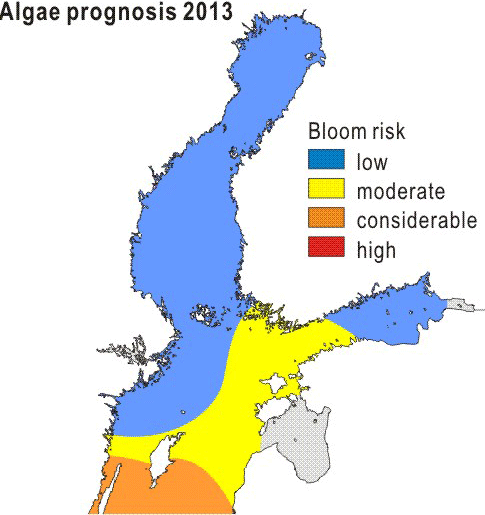Press release 2013-06-06 at 11:47
According to the algae prognosis of the Finnish Environment Institute’s Marine Research Centre, the risk of blue-green algal blooms in Finland's sea areas is mainly low this summer. In the western Gulf of Finland, the southern reaches of the Archipelago Sea, and in the north-eastern parts of the Baltic proper, there is a moderate risk of algal blooms. No major blooms are forecast in the Gulf of Bothnia.
The southern Baltic Sea faces the greatest risk of blue-green algal blooms.
The probability of blue-green algal blooms in Finland's sea areas is in general lower compared to the summer of 2012. Ultimately, the summer weather is the decisive factor determining when and in which areas major surface accumulations occur. Warm and calm weather increases the risk of major surface accumulations. If the current warm weather continues to prevail, the bloom risk increases.
The bloom period in Finland's sea areas is expected to peak in late July and early August. Two species of blue-green algae produce widespread accretions. The marine blooms of the species Aphanizomenonflos-aquae have not been shown to be toxic, although this species is known to be able to produce toxic blooms in lakes. The first accumulations of blue-greens in the summer are usually observed when the sea surface temperature reaches ca 15 degrees centigrade, and these consist of Aphanizomenonflos-aquae. As the sea surface temperature exceeds 17 degrees centigrade, the hepatotoxin-forming species Nodularia spumigena may begin accumulating in the surface.
Basis for the risk assessment
The blue-green algal bloom prognosis is based on estimates performed using the ecosystem models of the Finnish Environment Institute SYKE and the Finnish Meteorological Institute (FMI). These estimates are based on the average sea current, wind and temperature conditions (SYKE) or long-term meteorological forecasts (FMI), in addition to nutrient concentrations in the previous winter, and changes in these nutrient concentrations during the spring. In a summarising expert elicitation, uncertainty issues regarding the models are addressed, and experience of former prognoses and accumulated observational data analysed.
The phosphate concentrations in the Gulf of Finland and the northern part of the Baltic proper were lower in the winter, and also during the spring of 2013, than the average concentrations during the time period since the year 2000. The concentrations of so called excess phosphate, a variable which well describes the potential for blue-greens’ blooms, were also rather low in both of the sea areas mentioned, only approximately half of the corresponding concentrations the year before.
Current information on algal blooms starting
Starting this week and continuing until the end of August, the Finnish Environment Institute SYKE will provide weekly updates on the algae situation in the Baltic Sea and in inland waters.
Algae prognosis being developed for lakes
This is the second consecutive summer the Finnish Environment Institute SYKE provides algae prognoses also for lakes, as a trial. The prognostic model mainly describes whether the risk of algal blooms is greater or smaller, on average, than in previous years.
Results from applying the model are published in Järviwiki for 34 large lakes. These lakes are Pihlajavesi, Haukivesi, Kallavesi, Pielinen, Onkivesi, Porovesi, Juojärvi, Päijänne, Keitele, Vuohijärvi, Puula, Pyhäjärvi in Artjärvi, Mallusjärvi, Tuusulanjärvi, Lohjanjärvi, Hiidenvesi, Pyhäjärvi in Säkylä, Vanajavesi, Tarjanne, Längelmävesi, Isojärvi in the Karvianjoki river basin, Karvianjärvi, Karhijärvi, Kuortaneenjärvi, Lappajärvi, Lestijärvi, Pyhäjärvi in the Pyhäjoki river basin, Oulujärvi, Oijärvi, Inarijärvi, Ala-Kitka, Bodominjärvi, Lippajärvi and Pitkäjärvi in Espoo.
"Thus far, the algae prognoses for lakes have been uncertain, since the prognostic model does not include all factors influencing the growth of algae" says Leading Hydrologist Bertel Vehviläinen of the Finnish Environment Institute SYKE's Freshwater Centre.

Algea prognosis to media
Further information
Algae prognosis
Researcher Sirpa Lehtinen, SYKE's Marine Research Centre, firstname.lastname@ymparisto.fi , tel. +358 400 148 518
Ecosystem models
Researcher Kim Dahlbo, SYKE's Marine Research Centre, firstname.lastname@ymparisto.fi , tel. +358 40 748 9445
Lakes
Leading hydrologist Bertel Vehviläinen, SYKE's Freshwater Centre, firstname.lastname@ymparisto.fi , tel. +358 40 5615533
Hydrologist Markus Huttunen, SYKE's Freshwater Centre, firstname.lastname@ymparisto.fi , tel. +358 400 148 543
Communications
Chief Editor for Web Services Aira Saloniemi at SYKE, Communications, firstname.lastname@ymparisto.fi , tel. +358 400 148 875